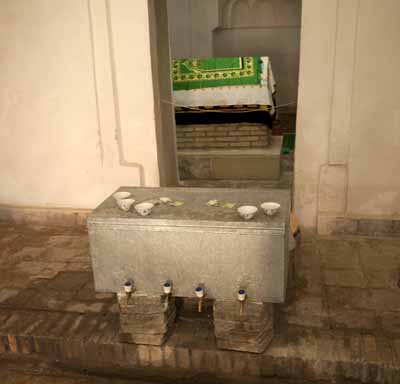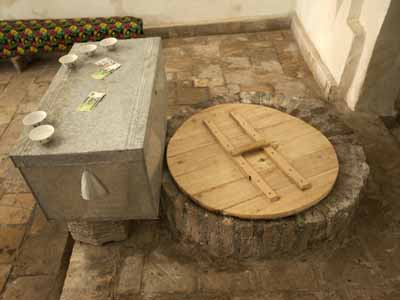Seven hundred feet northeast of Ismael Samani’s Mausoleum is the Spring of Job, he of Afflictions notoriety. According to legend, way back in Old Testament days, long before Jesus was even a gleam in Joseph’s eye (assuming you do not believe in the doctrine of the Immaculate Conception) Job was wandering around in Mawarannahr, the land north of the Amu Darya River. As if he did not have enough problems of his own, here in the valley of the Zerafshan River, where Bukhara is now located, he encountered a terrible drought. A famine raged and people were dying of thirst. Job in his rage at these conditions thrust his walking stick into the ground and amazingly enough sweet, cool water began to pour out of the hole he had made. This water source began known as the Spring of Job, or Chasma Ayub.
In the 12th century the Qarakhanid chieftain Arslan Khan, who then ruled Bukhara and as we shall soon see also built the famous Kalon Minaret, built a monument around the spring (which in fact appears to be a well). Apparently at least the foundation of this structure survived the Mongol assault on the city in 1220, and in 1380 or perhaps 1384 (a dated inscription over the door is unclear) Amir Timur, the immortal Tamerlane, apparently rebuilt or restored the existing structure and added a conical cupola on a high drum. This conical design is foreign to Mawarannahr, and at least one historian has speculated that it is the work of Khorezmian architects and builders who Amir Timur imported into the area after the fall of the Khorezemian capital to his troops in 1379 (Khorezm, as you know, is the ancient realm located on the lower Amu Darya, northwest of Mawarannahr). The other domes may date to as late of the sixteenth century.
Apart from its unusual domed cupola and other domes the starkly austere fortress-like building is devoid of any exterior ornamentation. Inside the Spring (or well) of Job still provides water which is said to imbued with beneficial qualities. Many people come here on pilgrimages both to drink the water straight from the well and to fill bottles to take home. Some women apparently believe that drinking the water will help them conceive children. Even in the short time I was present three woman who came in separately drank the water and then sat down on the nearby benches to engage in fervent prayer. Presumably these prayers will work in coordination with the active participation of their spouses. In any case, the water does seem quite sweet, especially compared with the notoriously lousy Bukhara city water, and only slightly mineralized. I am a connoisseur of drinking water and while the Spring of Job may not provide the tastiest water in the world it is certainly passable, and an extra fillip of interest is added by its association with Job.
Just behind well, in a separate room, is a tomb. Some tour guides and local touts insist that this is the tomb of Job himself. You may wonder how an Old Testament character ended up buried in Bukhara, but remember, Daniel, he of Lion’s Den fame, is said to be buried in Samarkand. Written histories and guidebooks, however, maintain a discrete silent about who may be buried here. But if the Afflicted One is not buried here then we must wonder who is?
Front of Chasma Ayub
Back of Chasma Ayub, showing the unusual conical dome on a high drum
Water spigots offering water from the Spring of Job. The tomb can be seen behind.
The Spring of Job (apparently a well) itself
The tomb behind the well. Does Job rest here after his Sojourn in this Vale of Tears?
























